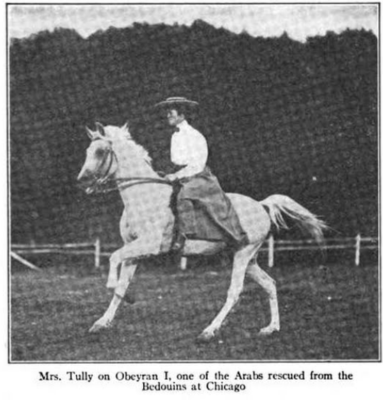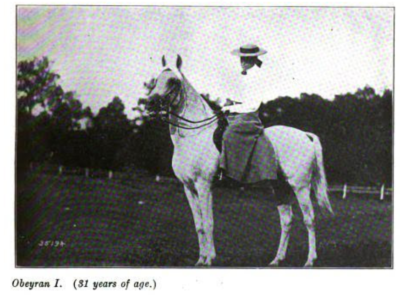Mrs. Eleanor Gates Tully and Obeyran I
“One of these horses, Obeyran I, is of the few rescued from the fanatic love of the Bedouins, which came so near proving the destruction of the entire importation of Arab horses brought to Chicago for the World’s Fair. By special permission of the Sultan of Turkey, twenty-eight Arab thoroughbreds were sent here for exhibition, with the express understanding that at the close of the fair every one was to be returned to the desert, alive or dead. This because of the perfect breeding and rarity of the animals selected.
The men who financed the exhibit became so involved that they could not pay the cost of the importation and exhibition of the horses, which were consequently seized for debt and were to be sold at auction. The Bedouins in charge of the horses, horrified at the thought of their passing into the hands of unbelievers, on the night previous to the auction entered the stables, cut the throats of five of the horses and burned nine others. Of the remaining fourteen, nearly all were sent to England. Obeyran I was one of three left in the United States, and he it was that bore the Princess Eulalia of Spain in the procession on the day when she received special honors at Chicago. The horse is now thirty years old, but under the saddle he has all the spirit and fire of a youngster.“
“One of the most remarkable Arabians is America is Obeyran I, or the Old Man, as he is dubbed at the ranch. He was born in the Palmyrian desert in 1879; when I ?rst saw him he had just been ridden at a gallop over seventeen miles of mountain. road, which was considered nothing at all in the way of a run, and he was then as full of life as a colt, impatient of restraint, restive at his tether and eager to be off again, all of which is remarkable in a horse thirty-one years of age. He is sound of wind and perfect of limb as in his early youth. He was pure white until he was twenty-six, when his snowy coat became flecked with gray. He was one of the twenty-eight Arabian horses and mares imported to this country in 1893, by special permission of the Sultan, to be shown at. the World’s Fair. They were all of exceeding rarity and value, and each of them was to be returned to the desert, dead or alive. But the men who ?nanced the project became involved in debt, the animals were seized, and an auction was announced. The Bedouin grooms, rather than give up their beloved charges to be profaned by the hand of a Christian, killed fourteen of them before they were discovered; of the remainder, all were shipped to England save three, one of which was Obeyran. Apparently he has not a few years of usefulness still before him—just what the length of his life will prove to be is a question of great interest. His is by no means an uncommon. case of longevity.”


First time I read about 14 of the Hamidie horses that were killed by their grooms. If I recall well, I did read somewhere that 7 died in fire.
It’s a fanciful account…
A very fanciful account. I had to note that she used the phrase “rescued” in relation to the Bedouin people that brought him and the others States-side, and I’ll admit, I rolled my eyes a bit there. It has always seemed to me that they were deeply disadvantaged in a strange land with strange customs and strange people that looked on them with something akin to the noble savage stereotype that Americans gave the indigenous Native American peoples. The sheer amount of mythology surrounding the Bedouin breeders of Arabian horses is staggering. And if you really want to get down to it, the acquisition of the Hamidie horses was hardly above-board.
Yes, very fanciful.
“all were shipped to England save three”; I have no idea where the writer got that. I have never heard that any of them went to England, and many more than three left records of careers in the U.S. after 1893: *Nejdme, *Obeyran, *Koubishan, *Halool, *Galfia, and *Mannaky, for example.
Is there a write-up on Koubishan and Halool anywhere online? I’ve heard a bit on Galfia, but nothing of substance on the other two. I’ve read the article that Charles and Jeanne Craver published on Peter Bradley, but that was about it.
Halool left no get, as far as we know, unless he was the sire of *Pride. *Koubishan was sold by Bradley to Davenport, who then sold him to — Shoemaker, who rode and drove him for some years. For some reason, his AHC registration #113 was cancelled. No reason is stated in the file. I’ll send a photo of him to Edouard, if he wishes to post it.
I’m due at the barn, but briefly, although it is true *Halool left no registered get (unless he sired *Pride), Homer Davenport did have a horse named Halool Jr. out of *Galfia. Pictured in the new edition of Homer Davenport’s Quest of the Arabian Horse, p. 400. Also I believe there were half-Arabian get of *Halool bred by Peter Bradley in his early years owning Arabians.
What makes us think *Halool sired *Pride? Is it because he was, with *Kibaby, supposedly one of the best of the Hamidie importation?
And *Koubishan, there is information about him in the new edition of Homer Davenport’s Quest of the Arabian Horse.
Sometimes I wish this platform had a “like” system akin to that of Facebook, if only to convey how much I adore the answers that continually come for my questions. Thank you, and wonderful to hear.
https://www.wiwfarm.com/BHArabsChicago.html
Patrick, that is an article by “Ben Hur,” the pen name of Herbert Tormohlen, Portland, Indiana, an early breeder (Ben Hur Farms) and writer about Arabian horses. My husband knew him, and took movies of him and his horses in the 1950s. He was very good at locating horses early in their careers, and using them before they became popular.
Look at those legs! Was there ever a methodical system of grading horses based on their body dimensions? If Obeyran was say 14.3 ish, from looking at his legs i’d say he had at least 8 inch cannon bone, possiblt 8 and 1/2. I know for example the Shagya breeders record their horses height, band width, and cannon size at their inspection trial. Similarly many endurance horse breeders,and riders too for that matter, list their horses cannon size in their advertisements.
However I don’t recall the older breeders from the 20’s through the mid 1980’s doing the same.
best
Bruce Peek